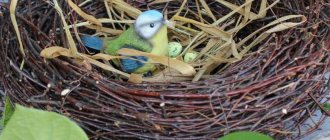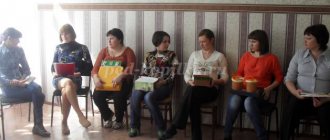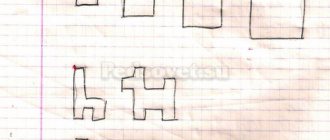MAGAZINE Preschooler.RF
Master class for teachers “The Wonderful World of LEGO”Goal: to create conditions for improving the professional skills of teachers in the process of active game interaction in mastering developmental methods and techniques using Lego construction.
Master class objectives:
- To acquaint teachers with experience in using Lego construction with preschool children
- To train master class participants in methods and techniques for using Lego games in the pedagogical process
- Develop interest, initiative, and desire to put these technologies into practice
- Arouse a desire for cooperation and mutual understanding.
Handouts: Lego - construction set, baskets, paint, glasses of water, napkins, task cards.
Equipment: multimedia equipment (projector, computer, background music)
The course of the master class.
Good afternoon, dear colleagues!
Today I invite you to plunge into the wonderful world of Lego. It is impossible to play without gaining knowledge, just as it is impossible to learn without playing.
Lego construction is a modern means of teaching children. The main thing is that Lego should be interesting to the teacher himself, then he will be able to interest the children too.
Let's imagine the situation.
You start teaching a physical education lesson, and then a child comes into the group with Legos, naturally the children are distracted by this Legos, what will you do in this situation? (teachers' answers)
I invite you to listen to my ideas on how you can use Legos in physical education and in children’s free activities.
Presentation demonstration - LEGO constructor can be used as equipment for conducting physical education classes and free activities for children.
You can do general developmental exercises with Lego cubes, depending on what the task is in the main types of movements:
- Charging with Lego elements.
- Lego jumping
- Walking on lego
- Rolling a ball through lego blocks.
- Crawling under an obstacle (Crawling arc)
- Maintaining balance exercises to develop coordination of movements
- Self-massage.
- Massage for the development of fine motor skills.
- Health path.
That's how many different exercises you can come up with with a Lego cube.
Using Lego in your activities also contributes to:
- Development of sensory concepts in children, since parts of different shapes are used, painted in primary colors;
- Development and improvement of higher mental functions (memory, attention, thinking, emphasis is placed on the development of such mental processes as analysis, synthesis, classification, generalization);
- Training the fingers of the hands, which is very important for the development of fine motor skills and will further help prepare the child’s hand for writing;
- Uniting the children's team, developing a feeling of sympathy for each other, as children learn to solve problems together, distribute roles, and explain to each other the importance of this constructive solution.
- Constructive activity is very closely related to the development of speech, because at first it is discussed with the child what he wants to build, from what parts, why, what quantity, size, etc., which later helps the child himself determine the final result of the work.
Practical part.
And now I propose to move on to the practical part and for this I invite participants who have Legos in their hands. I will give you cards with a task that you will complete yourself, after you complete it we will check how you coped with it.
Card No. 1
Topic: "Harvest"
Task No. 1: (the card shows vegetables and fruits)
- Name vegetables and fruits.
- Take the same number of green LEGO pieces as vegetables.
- Take as many red LEGO pieces as there are fruits.
- Compare the number of parts by color. Which ones are there more? Why?
Card No. 2
Topic: “Women’s Day” (the card shows a diagram of the construction of a flower, a vase template)
Task No. 1: What do you affectionately call your mother?
Task #2: Draw flowers for mom using a LEGO brick print.
Task No. 3: Make a flower for mom from a LEGO set according to the model.
Card No. 3
Topic: “Kindness rules the world”
Task No. 1: Color the picture. Place the LEGO brick in the correct box where the arrow points. A cube of the color with which you associate this picture.
Task No. 2: Make a gift for a friend who got sick from LEGO.
Card No. 4
Topic: “Look, how big we have become” (the card shows pictures: bus, mushroom, orange, cube, drum, hedgehog, pyramid, watermelon, pineapple, clock)
Task No. 1. Select and name only those pictures whose names begin with the vowel sound “A” .
Task No. 2. Using Lego construction parts, lay out the sound diagram of the words, depict vowel sounds with a red cube, and consonants with a blue cube. For example - hedgehog, pineapple, drum, watermelon.
While the girls are completing the task, I suggest you learn a little about the history of Lego.
(light music sounds)
LEGO HISTORY
The Lego Group was founded by Ole Kirk Christiansen (7 April 1891 – 11 March 1958). He was born into a poor farming family in Jutland, Denmark.
In 1932 he founded a company producing everyday items such as ironing boards and ladders. Christiansen named the new toy company lego, combining two Danish words - leg and godt (play and good).
In 1949, LEGO began producing “Automatically Connecting Blocks” with four or eight protrusions - they can already be recognized as the prototype of the future famous designer. In 1954, such cubes began to be called “LEGO bricks . The modern system for attaching cubes was patented later in 1958. The cubes became plastic with identical pins, which made it possible to connect them to each other.
After the death of Ole Kirk Christiansen in 1958, the company was headed by his son Gottfried, who continued his father's work with great zeal.
In those same years, the company was also developing its own “game system” - a certain set of basic and additional elements of the construction set, which became more and more complex every year. The cubes were later supplemented with transport figures, figures of people, then animals, many additional elements and many, many, many more cubes.
In 1973, the LEGO logo we know now appears. LEGO produces products for children of all ages, and adults also enjoy folding not-so-primitive bricks.
In May 2011, the Space Shuttle Endeavoro delivered 13 Lego sets aboard the International Space Station so that astronauts could build models and study how they react in the microgravity of space.
Conclusion.
I think our participants have finished their assignments and are ready to show their work?
Card No. 1
Topic: “Harvest” (Was it difficult to do this? What problem do you think you solved in the area?) cognitive area.
Card No. 2
Topic: “Women’s Day” (Was it difficult to do this? What problem do you think you solved in the area?) artistic and aesthetic area.
Card No. 3
Topic: “Kindness rules the world”
(Was it difficult to do this? What problem do you think you solved in what area?) social-commutative area
Card No. 4
Topic: . ” (Was it difficult to do this? What problem do you think you solved in the area?) speech development.
From this we can conclude that lego is used in all areas.
At the end of our meeting, I propose to build a pyramid of emotions. A red brick means that you liked this master class, a green brick means that you liked the master class, but you would like to see something else, well, a yellow brick will show that you didn’t like anything.
Thank you everyone for participating in the master class!
| Next > |
Lego construction in kindergarten. Master class with photos
Master class for preschool children.
Lego construction. Model of a well Author: Stepanova Galina Aleksandrovna, teacher of the Children's Development Center - Kindergarten No. 4, Kamyshlov Description of the material: The proposed master class on creating a working model of a well for children 4-5 years of age can be useful for teachers of additional education, educators and parents who solve problems and issues related to the technical education of children.
The master class has an educational focus related to technical creativity. Master class on Lego construction of a well model.
Goal: to create a working model of the simplest hydraulic structure designed to lift water - a well. Objectives: expanding and clarifying the understanding of the various details of Lego constructors, creating conditions for communication, self-realization and stimulating the growth of the creative potential of preschool children, developing design skills and technical creativity in preschool children, cultivating interest in the historical past of mankind. Material: Lego parts from the Lego Duplo 9656 set
Progress of the master class: Since finding non-standard solutions to problems during play activities is the basis of children's technical design, you can invite children to be transported to another reality. Teacher: Imagine a hot summer, drought and problems with water supply. The lack of water leads to a search for it. Where can you find a source of water? (underground). To bring water to the surface, you need a building that allows you to do this. What is the name of the simplest design of a hydraulic structure for lifting water? (well).What is a well, how can it be built? What elements/details of a well as a technical structure are important and significant? (log house/shaft, lifting devices). There is a type of lifting mechanism called a gate/axle. This mechanism allows for rotational movements. And today we will try to create a model of a well from Lego parts.
Take 4 2*4 bricks and lay them out in a square - this is the basis of the log house - the well shaft.
Take the next 4 2*4 bricks and secure them to the base of the frame using the "brickwork" method.
Next, we fix another layer of 2*4 bricks. The log house is ready.
We take 2*2 bricks in the amount of 6 pieces. We build 2 towers with 3 bricks each. We fix them on opposite sides of the frame according to class=”aligncenter” width=”623″ height=”467″[/img] Next operation: assembling the lifting device. Take 2 2*4 bricks with internal holes, an axle, a lifting handle, 2 rollers. A thread with a hook should be attached to one of the rollers. Assembly diagram: pass the axle through the central hole of one of the 2*4 bricks and secure it with a roller (so that it does not fall out). Then we put the second roller with thread on the axis. Next, a 2*4 brick and a handle for rotation are attached to the axis.
We fix the lifting mechanism on the log house building.
Let's start making a roof for the well. Take 4 bricks 2*2. We build and secure 2 towers.
I propose to make the roof of the well (arched type) using 2 2*4 plates and 6 2*4 bricks with a curve at the bottom. It can be explained why it is necessary to take bricks with a curve at the bottom (beaks): the slope facilitates the flow of water.
The well model is ready. Shall we play? Thank you for your attention.
We recommend watching:
Notes on Lego construction for older children using ICT “Travel to the country Notes of OOD for Cosmonautics Day. Lego design in the senior group of kindergarten Abstract of OD on lego design in the senior group of preschool educational institutions LEGO design as a means of developing constructive mathematical thinking in senior preschool children
Similar articles:
Development of mathematical concepts of children of primary preschool age in the design process








